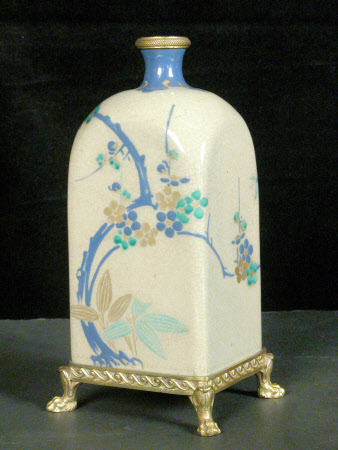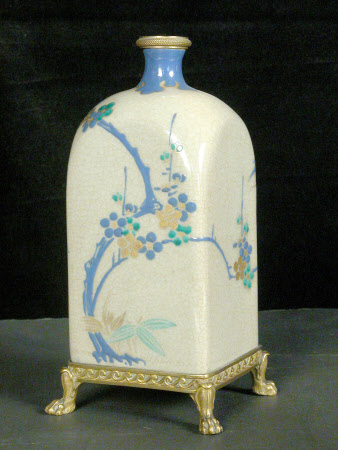Bottle
Category
Ceramics
Date
1700 (circa) - 1810 (circa)
Materials
Glazed stoneware decorated with enamels and gold and with ormolu mounts.
Place of origin
Kyoto
Order this imageCollection
Charlecote Park, Warwickshire
NT 532431
Summary
Pair of bottles, glazed stoneware, of square section narrowing at the top towards a small round neck, made near the Kiyomizu temple in Kyoto, probably second half eighteenth century, with mounts probably added in the early nineteenth century. Decorated on top of the off-white crackled glaze in blue and green enamels and gilding with prunus, pine and bamboo, and with a blue enamel collar around the neck. With an added European ormolu base decorated with a neoclassical wave scroll and with lion paw feet, the ormolu collar around the rim in the form of plaited reeds.
Full description
The shape of these bottles originated in Europe, where it was used for sets of bottles (transported in fitted cases) which held either alcoholic beverages or spice oils. In the late seventeenth and early eighteenth centuries this shape was copied by Japanese artisans in porcelain and lacquer produced for export to the West. Related examples in National Trust collections can be found at Belton House (NT 433355.1-2: Imari-style porcelain, NT 433468.1-2: Kakiemon-style porcelain), Dunham Massey (NT 929326: Imari-style porcelain), Polesden Lacey (NT 1245906.1-2: lacquer) and Wallington (NT 581625: Imari-style porcelain). Kiyomizu ware is a type of stoneware covered with an off-white or light brown crackled glaze and decorated with enamels and gilding, which was made near the Kiyomizu temple in the Higashiyama district of Kyoto. The decoration of Kiyomizu ware tended to be influenced by the highly stylised and colourful art of the Rimpa School of painters and artisans centred on Kyoto. These particular bottles are decorated with a gnarled prunus tree with pine and bamboo shoots – prunus, pine and bamboo are known as the ‘three friends of winter’ in East Asian art. Before the late nineteenth century, Kiyomizu ware was generally produced for the Japanese market, not for export. These bottles must therefore represent the adoption of this Western shape for certain Japanese usages, probably to serve sake (Japanese rice wine). The wealthy aesthete and collector William Beckford is known to have had a predilection for the types of East-Asian objects that were more difficult to obtain in Europe, so these bottles are consistent with his taste, as are the ormolu mounts that he was known to favour (i). Beckford acquired his extensive collection using wealth derived from his status as an absentee enslaver and plantation landlord (ii). He had inherited 15 plantations in 1770 (iii). Initially intended for auction in 1822, these bottles are described as ‘Lot 10: Two very ancient buff crackle flasks, green and blue enamel, on or-moulu stands with feet’(iv). The collection was eventually sold at a separate auction in 1823, where this piece and its companion were purchased by George Hammond Lucy (1789-1845) (v). (i) Derek E. Ostergard (ed.), William Beckford, 1760–1844: An Eye for the Magnificent, New Haven and London, Yale University Press in association with the Bard Graduate Center, 2001, cat. 65 (entry by John Hardy). (ii) See Boyd Alexander, (trans. and ed.), Life at Fonthill 1807-1822 With Interludes in Paris and London. From the Correspondence of William Beckford, (London: Rupert Hart-Davis, 1957); England’s Wealthiest Son: A Study of William Beckford, (London: Centaur Press Lt., 1962); Amy Frost, ‘The Beckford Era’ in Caroline Dakers (ed.), Fonthill Recovered: A Cultural History, (London: UCL Press, 2018), pp. 59-93 (ii) 'William Thomas Beckford', Legacies of British Slave-Ownership database, UCL, accessed 30/05/2024. https://www.ucl.ac.uk/lbs/person/view/22232 (iii)Christie, Manson and Wood, Magnificent Effects at Fonthill Abbey, Wilts., 1822, p.82 (iv) Warwickshire Record Office L6/1116
Provenance
Acquired by William Beckford (1760–1844); purchased by George Hammond Lucy (1789–1845) at the 1823 sale of the contents of Beckford’s country house, Fonthill Abbey (lot 1205), and thence by descent at Charlecote Park; on loan to the National Trust from Erica, Lady Fairfax-Lucy.

